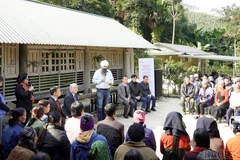
Hanoi (VNA) – On the occasion of International Women’s Day (March 8), Pauline Tamesis, Resident Coordinator of the United Nations in Vietnam, has written an article titled “Harnessing technology and innovation for social inclusion & gender equality”.

Below is the full text of the article:
“Technology compensates for my eyes", said Huong, a visually impaired student at Nguyen Dinh Chieu School in Hanoi.
Huong is one of many whose life has been transformed by digitalization. Before, Huong’s mother, Ms Hanh, sat next to her every night and every morning to reach each page for her to study. Now, Huong can use smart tools to access printed information just like a sighted person. This has opened a world of possibilities.
We have all experienced the transformative power of digitalisation. If not, this is what Huong tells us. Her story is an example of how the digital revolution creates enabling conditions in which all can thrive.
During the COVID-19 pandemic, the whole world shifted into online spaces like never before. It proved that digitalisation transforms how we work, learn, interact, and communicate. It opens new opportunities and breaks down traditional barriers to actively participate. It can improve well-being, education, health and livelihoods. For women and girls, digital transformation provides a unique opportunity to challenge gender stereotypes and shape their futures. Huong’s story is an excellent testament to this.
Yet, innovation and technology also risk perpetuating gender stereotypes and exacerbating inequalities. Women’s exclusion from the digital world has shaved 1 trillion USD from the gross domestic product of low- and middle-income countries in the last decade— a loss that will grow to 1.5 trillion USD by 2025 if no action is taken. Technological and digital innovation create, eliminate, and transform jobs, all in parallel. With IR4.0, automation and technological advancements will drastically cut demand for unskilled and low-skilled labour. Up to 86% of workers in Vietnam's textile and footwear industries are at risk of losing their job within the next 15 years.
This year’s International Women’s Day spotlights the digital divide between men and women and calls for an inclusive digital and technological transformation for everyone, everywhere. This theme is particularly timely and relevant in Vietnam as the Government embarks on an ambitious digitalisation journey. Digital transformation is needed in society and in the economy. It is considered as a vehicle to increase productivity, stimulate innovation, and ensure that Vietnam remains competitive internationally. Vietnam has already come a long way in providing equal access to technology, particularly to information and communications technology (ICT). Across the country’s 63 provinces, there is no noticeable difference between women and men, girls and boys, in access to ICT, exposure to media, mobile phone use, and having basic ICT skills. 91% of women and girls in Vietnam use cell phones.
Although having a device is critical, it is not sufficient for women and girls to harness the potential of digitalization. Women must also have equal opportunities to shape technologies and lead innovation. This starts in school. Boys significantly outnumber girls in pursuing careers in science, technology, engineering and mathematics (STEM). In Vietnam, only 36% of female graduates completing tertiary education are in STEM fields. 78% of students enrolled at Polytechnic University in Hanoi are male. Girls who pursue STEM education must first surmount a series of systemic, social and cultural barriers. Research finds that both teachers and female students had internalised cultural biases about their suitability to pursue STEM.
With the gap between girls and boys pursuing STEM, it comes as no surprise that innovation and tech industries have the greatest gender imbalance of all sectors. According to the International Labour Organisation, women account for only 37% of the tech workforce.
Studies show that companies with greater gender parity do better financially. Bringing women into technology results in more creative solutions and has greater potential for innovations that meet women’s needs and promote gender equality. A UNESCO conference held in Hanoi in 2015 already advocated that “the world needs science and science needs women.”
The equal inclusion of girls in STEM fields today lays the foundation for Vietnam’s prosperous digital transformation tomorrow. To meet the aspiration of becoming a high-income country by 2045, Vietnam’s digital journey must include all citizens as active contributors. This will also prove key to unlocking Vietnam’s continuous economic growth and achieving greater social inclusion in line with the 2030 Agenda for Sustainable Development. Three steps to take:
- Ensure gender-responsive policies on digital transformation and innovation.
- Break down barriers for girls to become future innovators and leaders in STEM.
- Anticipate the future of work. Ensure access to upskilling and reskilling programmes.
Let’s not replicate barriers for women and girls’ participation in the workplace of the future. On International Women's Day, join us in committing to a world where innovation and technology are harnessed to create a more equitable and just society./.




























